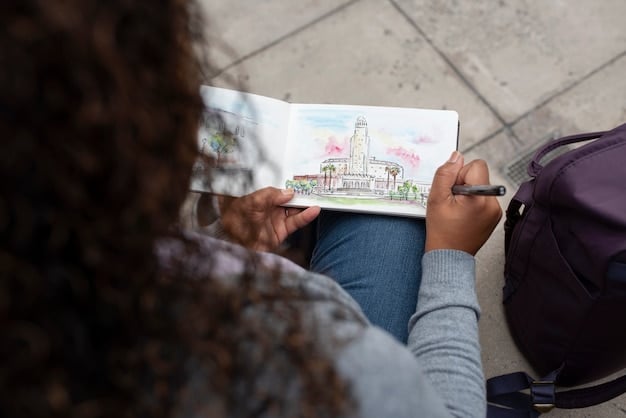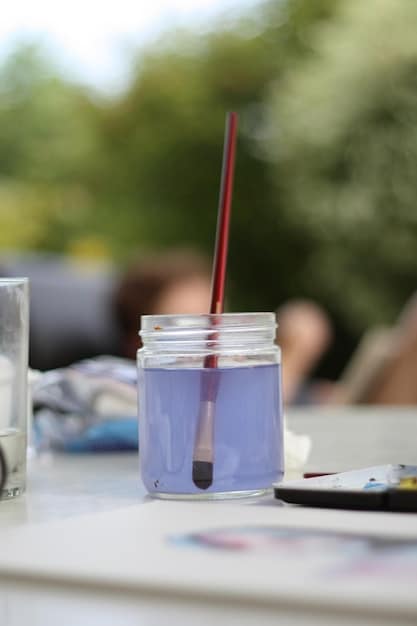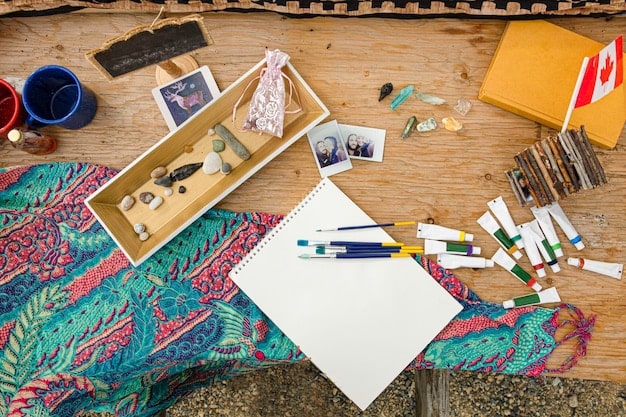Master Travel Sketching: Capture Memories with Pen & Paper

Mastering travel sketching involves developing observational skills, understanding foundational art techniques, and choosing the right portable tools to effectively capture the essence of your travel experiences in a tangible and deeply personal way.
Embarking on a journey, whether across continents or simply to a local park, often leaves us with vivid memories. While photographs excel at capturing precise moments, there’s a unique, immersive satisfaction in creating a travel sketchbook. This guide aims to help you master the art of travel sketching: capture your memories with pen and paper, offering a profound way to connect with your surroundings and preserve your adventures.
The enduring appeal of travel sketching
In a world dominated by digital photography, the act of travel sketching stands as a powerful testament to personal observation and interaction. It’s an intimate process that transforms passive sightseeing into active engagement, compelling you to see beyond the surface and truly absorb the details of a place.
Unlike a quick snap, sketching demands a slower pace, fostering a deeper connection with your environment. It’s not merely about replicating what you see, but about interpreting it, filtering it through your own perspective, and infusing it with your emotions and discoveries. This makes each sketch a unique artifact, far more personal than any mass-produced postcard or digital image.
Beyond the photograph: a personal narrative
While a photograph freezes a moment, a sketch captures a narrative. It allows for the omission of distracting elements and the emphasis of what truly resonated with you. This selective memory, rendered on paper, tells a story that is uniquely yours, reflecting your journey, not just the physical location.
- Sensory Engagement: Sketching involves multiple senses, as you observe light, shadow, texture, and even sounds, which subtly influence your drawing.
- Mindful Presence: The slow, deliberate act of sketching encourages mindfulness, grounding you in the present moment.
- Enhanced Memory Retention: The detailed observation required for sketching deeply imprints memories, making them more vivid and lasting than fleeting glances.
The beauty of travel sketching lies in its imperfection. Each line, each smudge, speaks to the moment of its creation, carrying with it the ambient sounds, the fleeting light, and the feeling of the place. It’s an unedited, authentic reflection of your experience, making it an invaluable keepsake for years to come.
The act of choosing what to sketch also refines your eye. You begin to notice compositions, contrasts, and atmospheric effects that might otherwise pass unnoticed. This heightened awareness enriches your travels, turning every scene into a potential frame for your artistic endeavors.
Ultimately, travel sketching is about creation and connection. It’s about building a visual diary, a tangible collection of moments, feelings, and observations that can transport you back to your adventures long after they’ve ended. It transforms travel from an ephemeral experience into a rich, artistic journey.
Essential tools for the aspiring travel sketcher
Embarking on your travel sketching adventure doesn’t require an overwhelming array of supplies. The key is to select portable, versatile tools that complement your style and the nature of your travels. A minimalist approach often fosters greater creativity and reduces the burden of carrying heavy equipment.
Think about what you truly need to capture the essence of your surroundings. Simplicity can often lead to more natural and spontaneous sketches, reflecting the fleeting moments of travel.
Sketchbook and pens: your primary companions
Your sketchbook is arguably your most important tool. Choose one that is comfortable to hold, durable enough to withstand travel, and features paper suitable for your chosen mediums. Wire-bound sketchbooks often lay flat, making them easier to work in on the go.
- Size Matters: A6 or A5 size sketchbooks are portable and discreet, ideal for quick sketches.
- Paper Quality: Look for paper with a weight of at least 150gsm (grams per square meter) to prevent bleed-through, especially if using markers or light washes.
- Pen Variety: A waterproof fineliner (e.g., Micron or Faber-Castell Pitt Artist Pen) in a few sizes (0.2, 0.5) is excellent for line work. A water-soluble pen (e.g., a fountain pen with non-waterproof ink) can create interesting washes.
Beyond pens, a simple graphite pencil (HB or 2B) for initial light outlines and an eraser (kneaded or soft vinyl) for corrections are invaluable. These basics provide a solid foundation for capturing form and perspective before committing to ink.
Consider adding a white gel pen or opaque white marker for highlights, or a black brush pen for adding bold strokes and shadows. The versatility of a few well-chosen pens can mimic a wide range of textures and tones.
Adding color: portability and impact
While black and white sketches have their own charm, adding color can bring your travel memories to life. Portability is paramount here, so consider compact options.
- Portable Watercolor Set: Small pan sets (12-24 colors) are incredibly versatile and easy to carry. Look for sets with a built-in mixing palette and a water brush.
- Water Brushes: These self-contained brushes carry water in their barrel, eliminating the need for a separate water container.
- Colored Pencils: A small set of high-quality colored pencils offers control and precision, ideal for adding subtle hues or vibrant details without water.
A small cloth or paper towel is also essential for dabbing excess water from your brushes and for cleaning. A bulldog clip can help hold pages open or secure loose papers.
Ultimately, the best tools are those you feel comfortable using and that encourage you to sketch. Start simple, experiment, and gradually build your kit as you discover what works best for your personal travel sketching style.
Don’t forget a small, lightweight bag or pouch to keep all your supplies organized and easily accessible. This ensures you can pull out your tools and begin sketching whenever inspiration strikes, whether you’re waiting for a train or enjoying a coffee in a bustling square.

Overcoming common challenges in travel sketching
Travel sketching, while immensely rewarding, comes with its own set of unique challenges. From capturing fleeting moments to dealing with unpredictable environments, maintaining composure and adapting your approach are key to success. Understanding these obstacles can help you prepare and develop strategies to overcome them effectively.
The very spontaneity of travel can be both a blessing and a curse for the sketcher. Embrace the imperfect, the quick rendering, and the sense of urgency that often accompanies on-the-go artistry.
Time constraints and fleeting subjects
Travel often means a tight schedule, leaving little time for elaborate sketches. Subjects like people or moving vehicles are even more challenging as they don’t stay still. This necessitates a shift in mindset from detailed rendering to capturing the essence.
- Quick Gestures: Practice rapid gesture drawing to capture the pose or overall movement of a subject in seconds.
- Focus on Key Elements: Instead of drawing everything, identify and prioritize the most characteristic features of a scene or person.
- Sketch in Stages: Break down complex scenes into smaller, manageable parts that you can sketch quickly and then combine later.
Don’t be afraid to leave parts unfinished. An incomplete sketch can still convey a powerful impression. The aim is often to capture a feeling or a memory, not to create a photographic replica.
Sometimes, the best approach is to take mental notes, sketch a very quick outline, and add details later from memory or reference photos if absolutely necessary. This allows you to stay present but still record the core information.
Dealing with crowds and curious onlookers
Sketching in public, especially in popular tourist areas, often attracts attention. While most onlookers are supportive, some may be overly curious or even disruptive. Learning to manage these interactions is part of the travel sketching experience.
- Find a Good Spot: Seek out less crowded corners or elevated vantage points where you can sketch with more privacy.
- Be Confident Yet Polite: A confident demeanor can deter excessive questioning. A simple smile and nod usually suffice. If someone is genuinely interested, a brief, pleasant exchange is fine.
- Wear Headphones: This provides a clear signal that you are focused and less likely to engage in conversation, creating a personal bubble.
Embrace the challenge of sketching amidst activity. Sometimes, the movement of people adds life and character to your scene. View onlookers as part of the dynamic environment you are capturing.
Remember, your sketchbook is for you. The process of creation is paramount. Don’t let external factors derail your creative flow. With practice, you’ll develop a natural rhythm that allows you to sketch effectively in diverse public spaces.
Finally, external factors like weather (wind, rain, extreme heat or cold) can pose challenges. Dress appropriately, find sheltered spots, and protect your materials. Adaptability is your greatest asset in overcoming these practical hurdles, ensuring that the joy of sketching remains uninterrupted.
Developing your observational skills for sketching
The foundation of compelling travel sketches lies in keen observation. It’s not just about looking, but seeing deeply—perceiving shapes, understanding light and shadow, and interpreting the essence of a scene. Developing these skills transforms mere sightseeing into a rich visual exploration, leading to more dynamic and expressive artwork.
Good observation is a habit cultivated through conscious practice, allowing you to notice details that often escape a casual glance. It’s about training your eye to dissect complex realities into simpler forms and values.
Breaking down complex scenes
A bustling market or a grand cathedral can seem overwhelming to sketch. The trick is to simplify and break down the scene into fundamental components. Start with the big shapes and work your way down to the details.
- Identify Basic Shapes: Look for underlying geometric forms (rectangles, circles, triangles) within larger structures and objects.
- Perspective and Placement: Determine the horizon line and vanishing points to establish accurate depth and perspective.
- Establish Proportions: Use comparative measurement techniques (e.g., comparing the height of a building to its width) to get elements in scale.
Don’t try to draw everything perfectly from the start. Focus on getting the overall composition and proportions correct. Details can be added or suggested later.
Squinting your eyes can help you abstract the scene, reducing it to its dominant shapes and light patterns, making it easier to identify the core elements you wish to capture.
Harnessing light and shadow
Light and shadow are crucial in creating depth, mood, and form in your sketches. They define the contours of objects and describe the time of day, adding character and realism.
- Direction of Light: Observe where the main light source is coming from and how it casts shadows.
- Value Scale: Pay attention to the varying degrees of lightness and darkness (values) in the scene, from bright highlights to deep shadows.
- Form and Volume: Use shading to convey the three-dimensional quality of objects, making them appear solid rather than flat.
Practice sketching simple objects under different lighting conditions to understand how light interacts with form. This fundamental exercise builds a strong visual vocabulary.
Capturing the quality of light—whether it’s harsh midday sun, soft morning glow, or dramatic twilight—adds immense evocative power to your travel sketches, transporting viewers directly into that moment and atmosphere.
Ultimately, developing observational skills is an ongoing journey. The more you sketch, the more attuned you become to the visual world around you, enriching not only your artwork but your overall travel experience.
Incorporating storytelling into your travel sketches
Travel sketching isn’t merely about depicting a scene accurately; it’s about weaving a narrative, imbuing your drawings with the stories and emotions of your journey. Each line and color can contribute to a richer, more personal account of your experiences, transforming a simple sketch into a powerful memory capsule.
Think of your sketch not just as a picture, but as a page from a visual diary, filled with anecdotes and feelings that bring your travels to life.
Adding context and atmosphere
Beyond the main subject, consider how background elements and atmospheric effects can enhance your story. These details provide context, illustrating where you were and what the environment felt like.
- People and Activities: Include glimpses of local life—a street vendor, children playing, people waiting for a bus—to add a sense of place and activity.
- Weather and Time of Day: Use color and light to convey the weather (e.g., a stormy sky, hazy sun) or the time of day (e.g., long shadows of late afternoon, soft morning light).
- Local Details: Incorporate unique architectural features, specific motifs, or local flora/fauna that define the region.
These contextual elements transform a generic drawing of a building into a vibrant scene alive with the character of its location. They hint at the broader narrative unfolding around you.
Even small, seemingly insignificant details, like a specific type of streetlamp or a patterned piece of fabric, can ground your sketch in a particular place and time, enriching its storytelling potential significantly.
Embracing serendipity and imperfections
Travel sketches are not meant to be flawless. The beauty often lies in their spontaneity, in the slight wobbles of a line drawn on a bumpy train ride, or the smudged colors from a sudden rain shower. These “imperfections” are what make your sketches authentic and tell a deeper story.
- Capturing Fleeting Moments: Don’t erase every mistake. Sometimes, a quick, imperfect line better captures a pose that lasted only a second.
- Annotate Your Sketches: Add handwritten notes about the date, time, location, sounds, smells, or even conversations you overheard.
- Allow for Accidents: A spilled coffee ring or a splotch of ink can become part of the story, a unique mark of your journey.
These elements turn your sketchbook into a truly personal travelogue, a testament to the real, unpolished experience of exploring the world. They add layers of meaning that a perfect, sterile rendering would lack.
Remember that the act of sketching itself becomes part of the memory. The challenges you faced, the conversations you sparked, and the moments of quiet contemplation are all intertwined with the lines on your page, making each sketch a rich trove of experienced narrative.
By consciously incorporating storytelling into your travel sketches, you elevate them from simple drawings to cherished chronicles, filled with the unique magic of your adventures.
From sketch to lasting memory: organizing and sharing your work
Creating travel sketches is a wonderful pursuit, but the journey doesn’t end when the ink dries. Organizing your work and considering how you might share it are crucial steps in transforming your temporary artistic endeavors into lasting memories and sources of inspiration. The way you curate and present your sketches can significantly enhance their value and impact.
Think of your sketchbook not just as a collection of drawings, but as a personal archive, a tangible record of your adventurous spirit and observations.
Protecting your travel memories
Your sketchbook is a precious artifact of your travels and deserves protection. Over time, pages can yellow, colors can fade, and physical damage can occur if not properly cared for. Simple habits can extend the life of your creations.
- Proper Storage: Store your sketchbooks flat in a dry, cool place, away from direct sunlight. Archival boxes can offer an extra layer of protection.
- Interleaving Pages: If you use wet mediums like watercolor, place a sheet of tracing paper or glassine between pages to prevent colors from transferring.
- Digital Backup: Scan or photograph your favorite sketches. This not only creates a digital archive but also makes sharing easier without risking the original.
A simple fixative spray (used in a well-ventilated area) can help prevent smudging of pencil or pastel sketches. Investing in these small protective measures ensures your travel memories endure.
Consider labelling the spine of your sketchbooks with dates and destinations. This makes it easier to locate specific journeys and turns your collection into a growing library of visual diaries.
Sharing your artistic journey
While travel sketching is often a deeply personal activity, sharing your work can bring new perspectives and connect you with a wider community. Decide how and with whom you feel comfortable sharing.
- Online Galleries: Platforms like Instagram, Behance, or a personal blog are excellent for showcasing your work and getting feedback. Use relevant hashtags like #travelsketching, #urbansketchers, or #sketchbook.
- Local Art Groups: Join local sketching groups or urban sketchers meetups. Sharing in person can be incredibly motivating and provide valuable critiques.
- Printed Albums or Books: For a more tangible sharing experience, consider creating a small print-on-demand book or a photo album exclusively dedicated to your travel sketches.
When sharing online, always include a brief caption describing the location, date, and perhaps a small anecdote about the moment you sketched it. This storytelling aspect enriches the viewing experience for others.
Sharing is not just about showing off; it’s about inspiring others, documenting your personal growth, and fostering a sense of community among fellow artists and travelers. It solidifies your unique perspective on the world and the art you create from it.
Whether kept private or shared widely, the beauty of travel sketching lies in its ability to transform fleeting experiences into tangible, meaningful artifacts, allowing you to relive your adventures with every turn of a page.

Beyond the basics: advanced techniques and perspectives
Once you’ve mastered the foundational elements of travel sketching, there are myriad ways to expand your artistic horizons. Advanced techniques and a willingness to explore different perspectives can elevate your work, adding complexity, unique insights, and even deeper emotional resonance to your visual narratives.
Pushing past your comfort zone allows for artistic growth, transforming your sketches from mere renderings into sophisticated works that truly capture the nuanced essence of a place.
Experimenting with mixed media
Don’t limit yourself to just pens and watercolors. Combining different mediums can create rich textures, vibrant effects, and add unexpected dimensions to your sketches. Mixed media offers a playground for creative expression.
- Pen, Ink & Wash: Use waterproof ink for crisp lines and then apply dilute watercolor washes over them for subtle color and atmospheric effects.
- Colored Pencils & Markers: Combine the precision and blending capabilities of colored pencils with the bold, even coverage of markers to create dynamic contrasts and vibrant hues.
- Collage Elements: Incorporate tickets, maps, found papers, or even small fabric scraps from your travels directly into your sketches to add tactile texture and a unique storytelling layer.
Experimenting with mixed media challenges you to think differently about how materials interact, fostering innovative approaches to your compositions and color palettes. It often leads to delightful surprises.
Always consider the paper quality when working with multiple mediums, ensuring it can withstand the different layers without buckling or bleeding through. A heavier paper weight is typically best for mixed media experimentation.
Exploring unusual perspectives and compositions
Most beginners sketch at eye level, but changing your vantage point can dramatically alter the impact and narrative of your drawing. Seeking out unique perspectives forces you to observe more critically and present familiar scenes in novel ways.
- Above or Below: Sketch from a high vantage point (a rooftop, a hill) to capture sweeping landscapes, or from a low perspective (looking up at a building) to emphasize scale and grandeur.
- Through a Frame: Use natural frames like doorways, windows, or archways to focus the viewer’s eye and add depth to your composition.
- Close-ups and Details: Instead of grand scenes, zoom in on intricate details—a texture on an old wall, a unique door knocker, a pattern on a mosaic—to capture the essence of a place through its smaller elements.
These varied compositions offer different narratives and emotional tones. A close-up can evoke intimacy, while a wide shot provides context and scale. Experimentation is key to finding your compelling visual voice.
Try sketching quickly from several different angles before settling on one. This rapid succession of small exploratory sketches can unlock unexpected and more dynamic compositions.
Ultimately, advanced travel sketching is about continuous learning and personal expression. It’s about pushing boundaries, daring to experiment, and finding new ways to translate the richness of your travels onto the page, creating truly unforgettable artistic legacies.
| Key Aspect | Brief Description |
|---|---|
| 🎨 Essential Tools | Portable sketchbook, water-soluble pens, and a compact watercolor set are fundamental for on-the-go artistry. |
| 👁️ Observational Skills | Learn to simplify scenes, capture core shapes, and effectively use light and shadow to create depth. |
| 📖 Storytelling Focus | Incorporate local life, atmospheric conditions, and personal annotations to add narrative depth to your sketches. |
| 🖼️ Archiving & Sharing | Protect your work through proper storage and consider sharing digitally or in print to inspire others and preserve your journey. |
Frequently asked questions about travel sketching
▼
For travel, a sketchbook in A5 (5.8 x 8.3 inches) or A6 (4.1 x 5.8 inches) is often ideal. These sizes are compact enough to carry easily in a small bag, making them convenient for quick sketches on the go without being cumbersome. Larger sizes can be unwieldy and draw too much attention in crowded spaces, whereas smaller ones promote rapid studies.
▼
Absolutely not. Travel sketching is about capturing memories and personal experiences, not necessarily creating museum-worthy art. Even simple, raw sketches hold immense personal value. The primary goal is to engage more deeply with your surroundings and preserve your journey in a unique, tangible way. Skill develops with practice, but enjoyment begins immediately.
▼
Focus on capturing the essence rather than every detail. Start with loose gesture drawings, focusing on main shapes and proportions. Don’t be afraid to leave parts unfinished; often, a few key lines and a splash of color are enough to evoke a memory. Working under time pressure can train your eye to identify and prioritize essential information quickly.
▼
A portable watercolor pan set with a water brush, or a small set of colored pencils, are excellent options. Watercolors offer vibrant washes and are very compact, especially pan sets that often include a mixing palette. Colored pencils offer precision and no drying time, making them ideal for quick applications and subtle details. Both are highly portable and versatile.
▼
Most watchers are curious and supportive. Find a comfortable, less crowded spot if possible. If approached, a simple smile and a brief, polite explanation of what you’re doing are usually sufficient. Wearing headphones can also signal that you prefer not to be disturbed. Over time, you’ll feel more confident and less self-conscious, focusing on your art.
Conclusion
Mastering the art of travel sketching: capture your memories with pen and paper offers a profoundly enriching dimension to your adventures. It transcends mere visual documentation, fostering a deeper engagement with your surroundings and etching experiences into your memory in an incredibly personal way. From selecting the right tools to honing your observational skills and embracing the narrative power of each stroke, this practice transforms travel into an active, creative meditation. By valuing the process as much as the outcome, and by sharing your unique interpretations, you not only preserve your journeys but also inspire others to explore the world, both inwardly and outwardly, through the timeless appeal of a sketchbook. Every line and splash of color becomes a tangible piece of your story, a personal artifact to treasure for a lifetime.





